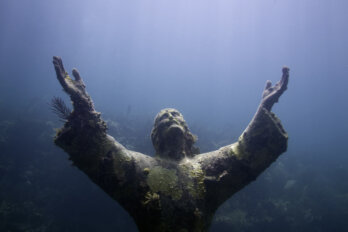At the Errington wildfire base on Vancouver Island, in British Columbia, a three-person Initial Attack Crew is “on reds,” the maximum alert level. A blue and silver Airbus AStar helicopter loaded with 320 kilograms of fuel stands by, ready to go at a moment’s notice. “It’s skids off the ground within five minutes of getting the call,” firefighter Josh McLennan, twenty-one, says.
McLennan is part of the Coast Tango crew, which has been battling a week-old blaze above Sproat Lake, twenty minutes by air from the base. Along with Russell Robertson, thirty-four, he was aboard the first helicopter to respond to smoke rising from the old-growth forest that covers the slopes of Dog Mountain, a rounded peak that towers above lakefront cottages. On their way in, Robertson took aerial photos with his phone. They show a plume billowing high into the air—silent among the trees but indicative of a raging blaze. Even before they landed, they knew the conflagration was going to be big. Air-tanker support was already on its way. The fire doubled in size within days.
The flames blackened tree trunks and sent rocks and logs careering down steep cliffs. Its intensity and the presence of what firefighters call “the values”—lakefront properties, in this case—meant that Robertson and McLennan started a twenty-six hour shift when they stepped off the helicopter. With their crew leader, Jessica Duncan, they set up sprinklers to protect cottages and cleared landing pads for incoming helicopters by hacking away trees and brush. “We tried taking a nap,” Robertson says, “but I’m not a napper.” Like most IAC firefighters, the three spent much of their time with their “feet on the ground and hands in the dirt”—almost obsessively concerned with safety. “It’s engrained,” Robertson says.
British Columbia employs 1,100 wildfire fighters each year, many of them seasonal provincial employees. Initial Attack Crews—there are scores of them—comprise the first responders to flames. “You’re not sure when you head out: you could be gone for a few hours or for fourteen days,” McLennan explains.
While on reds, each crewmember has his or her bag packed and ready. “I have a pair of boxers, a toothbrush, and some toothpaste,” Robertson says. “You throw that in the heli and away you go.” With strict load limits and the helicopter cabin crowded with gear and safety equipment, firefighters’ bags—and bodies—must be as light as possible. They spend one hour per day on fitness, whether to bulk up or slim down. On a whiteboard propped up next to their lockers, they track their progress. McLennan is fine, well under the maximum of 200-pounds (including boots and helmet); Robertson, sturdy and at least six feet tall, faces more of a challenge. “You get a fat letter when you hit 195,” someone says, laughing.
Ninety percent of wildfires in Canada are fought by helicopters, skimmer aircraft, and endless kilometres of hose. Depending on the severity of the season, between $500 million and $1 billion is spent on fire suppression annually. “There’s always people invested in the forest,” Roberston says. “We want to protect their investments.” Decisions on which fires to fight are made by management officials who assess the values. In BC, that means more than cottages, communities, and ecosystems. It often means timber: “Nowadays, there aren’t many areas of the province that aren’t valuable to someone.”
Years of eager fire suppression—the fighting of any spark, flame, or hotspot—have led to an enormous buildup of what officials call “fuel.” Dry, dead wood is scattered on forest floors like stacks of kindling. “When the natural fire cycle is interrupted,” states BC’s Wildland Fire Management Strategy, “fuels build to unnatural levels, increasing the risk of catastrophic wildfires that are difficult to control.”
So far this year, nearly 4 million hectares have burned, compared with just 1.5 million this time last year. The federal government predicts that, compared to the 1990s, affected areas will increase by 50 percent by 2040, and the province warns that uncontrollable “mega fires” will become more common with climate change. “When you put out all the fires, when you plant a monoculture, when you change the entire landscape,” McLennan says, “things are going to burn.”
A week after the Dog Mountain blaze started, a light rain began to fall on Errington—the first moisture in weeks. Will it help with fires burning across the Vancouver Island Ranges? Robertson shakes his head. “If you walked into the forest,” he says, “you wouldn’t see any rain hitting the ground.”
In the locker room, McLennan folds socks into pairs as he unloads the dryer. It’s a slow day for first responders, and the “uppers” are reporting that the larger “unit crews” now on Dog Mountain have the fire under control. A helicopter lands on the concrete pad outside the door, and the next standby shift begins. Tom Langdon, a fifty-seven-year-old helicopter pilot who started flying wildfire contracts in the early 1990s, shakes off his coat as he steps out of the rain. “It’s a lot of hours of boredom,” he says of shuttling IACs from site to site. “Boredom punctuated by moments of terror.”





